Sighisoara is a destination that should be on every traveler’s bucket list. With its stunning architecture, rich history, and charming atmosphere, this medieval city is a true gem of Transylvania. Whether you’re interested in history, culture, or outdoor activities, Sighisoara has something to offer everyone.
In this blog post, we’ll take you on a journey through some of the highlights of our trip and we’ll cover some of the best things to see in Sighisoara.
About Sighisoara
Sighișoara is a historic city located in the heart of Transylvania, Romania. It is widely regarded as one of the last few fortified and walled cities in Europe that has managed to retain its medieval charm and architecture.
Often referred to as the “Pearl of Transylvania”, the city is surrounded by hills and forests, making it a picturesque destination that is perfect for those who love nature and outdoor activities.
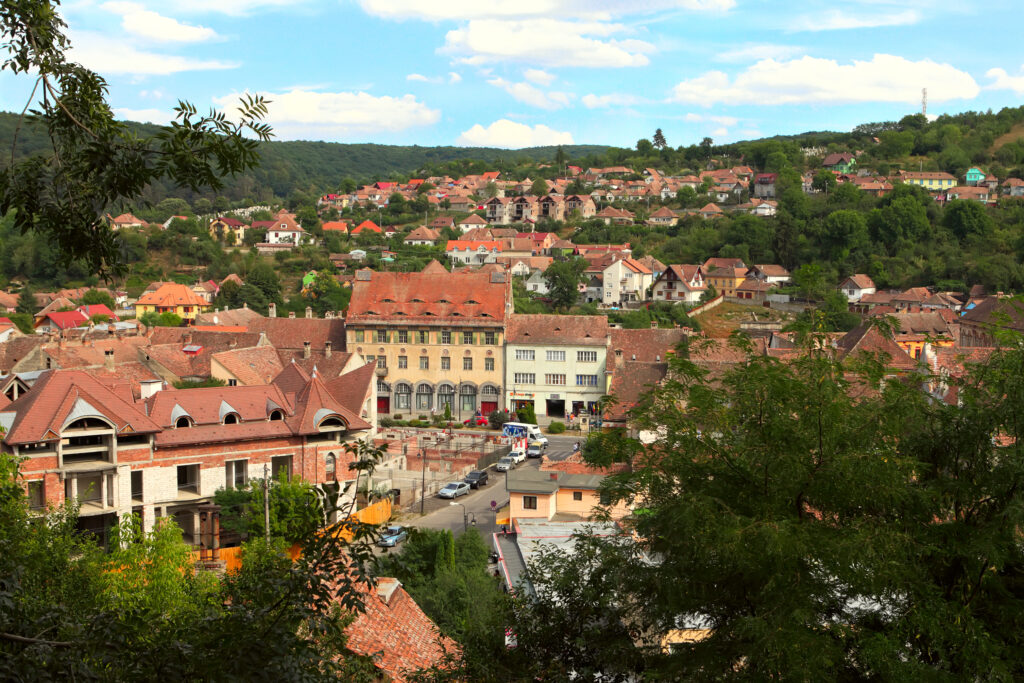
The most iconic feature of Sighișoara is it’s medieval citadel, also known as the Upper Town or the Fortress, which has been designated as a UNESCO World Heritage Site. The citadel is situated atop a hill and is surrounded by imposing defensive walls, watchtowers, and bastions. Its well-preserved fortifications offer visitors a glimpse into the medieval era and provide breathtaking views of the surrounding landscape.
Within the citadel, there are numerous historical landmarks and attractions. One of the most notable sights is the Clock Tower, a 64-meter-tall structure that dates back to the 14th century. Another highlight of Sighișoara is the Church on the Hill, a Gothic-style church also built in the 14th century.
Wandering through the narrow, cobbled streets of the citadel, visitors can explore charming houses with colorful facades, small squares, and cozy cafes. The city’s unique atmosphere and well-preserved architectural heritage make it a popular destination for tourists and history enthusiasts.
In addition to its historical significance, Sighișoara hosts various cultural events and festivals throughout the year, including the Medieval Festival, which celebrates the city’s rich medieval heritage. During this festival, the citadel comes alive with medieval reenactments, traditional music, and artisanal crafts.
Short History
The origins of Sighișoara can be traced back to the 12th century when it was established by German craftsmen and merchants, known as the Saxons, who settled in the area. The city quickly developed into an important trading and cultural center within the region. Over the centuries, Sighișoara grew in prominence and became a strategic stronghold due to its location on trade routes linking Central Europe with the Ottoman Empire and the Black Sea.
Over the centuries, Sighisoara became an important center of trade and commerce, as well as a hub of art and culture.
One of the most famous residents of Sighisoara was Vlad the Impaler, who was also known as Dracula. Although he did not live in the city, he was born in the nearby town of Sighisoara and is often associated with the region.
Today, visitors to Sighisoara can visit the house where Vlad was born, which has been turned into a museum that showcases the history and legends of Dracula.
Our Hotel
From the moment we arrived at the Central Park Hotel, we knew we were in for a treat. The hotel is located in the heart of the city, just a few steps away from the historic center and all the main attractions. We were greeted by friendly and welcoming staff who made us feel right at home.
The rooms at Central Park Hotel are spacious, comfortable, and beautifully decorated. We stayed in a beautiful room room that was complete with all the amenities we needed. The highlight of our room was the view that overlooked the park, offering stunning views of the surrounding hills and forests.
Things to See
Umbrella Street
Our first stop in Sighisoara was the famous Umbrella Street. This colorful and whimsical street is covered in hundreds of umbrellas of all colors and sizes, creating a vibrant and joyful atmosphere. It’s a popular spot for photos for anyone visiting Sighisoara.
Artizanat Ceramica
Tucked away on a quaint little street, we stumbled upon a local shop called Artizanat Ceramica, which sells handcrafted pottery, ceramics, and souvenirs that are all made by local artisans.
As we stepped into the shop, we were greeted by the warm smile of the shop owner. She kindly offered to guide us through the collection and tell us the stories behind several pieces she was selling.
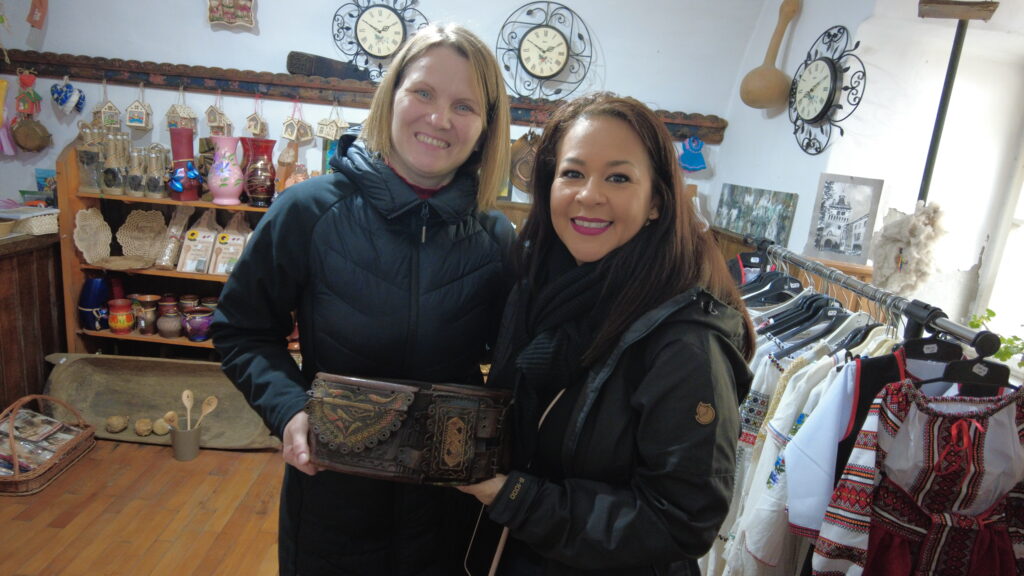
We wandered around and saw shelves full of colorful and intriguing objects. From ceramics to clothing and everything in between, Artizanat Ceramica truly lived up to its name as a place for handmade crafts.
One particular item caught our attention – a chimir, which is a traditional leather belt. The shop owner excitedly shared its history with us. Hand-stitched and meticulously crafted, this chimir dated all the way back to 1929. The attention to detail craftsmanship evident in every stitch left us in awe.
Moving through the shop, we marveled at the exquisite handmade ceramics. Each piece seemed to carry its own story, intricately painted and beautifully glazed. From practical household items like plates and mugs to delicate trinkets, Artizanat Ceramica had something for everyone.
Clock Tower
Next, we walked towards the Clock Tower, the most iconic landmark in Sighisoara. Standing at 64 meters tall, it dates back to the 14th century and is the symbol of the city. The tower houses a museum with exhibits showcasing the history and culture of Sighișoara, including medieval artifacts and documents. It is also home to a unique mechanical clock with figurines that come to life on the hour.
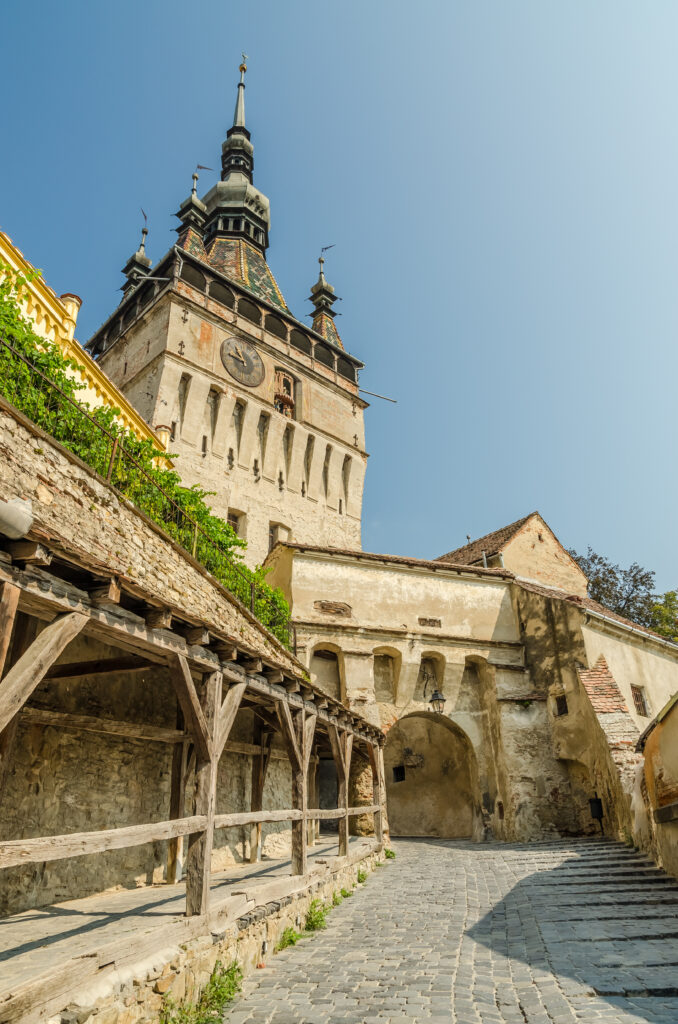 The famous Clock Tower of Sighisoara
The famous Clock Tower of Sighisoara
As luck would have it, we arrived just in time for a special treat. The clock was about to strike noon! We joined the growing crowd of locals and fellow tourists who had gathered in front of the tower, eagerly awaiting the chiming of the bells.
 Don and Edith with the Clock Tower in the background
Don and Edith with the Clock Tower in the background
Vlad the Impaler’s Childhood Home
We stumbled upon the childhood home of a rather infamous figure in history – Vlad the Impaler. If you’re not familiar with him, don’t worry, we’ll fill you in.
Vlad the Impaler, also known as Vlad III or Vlad Dracula, was a 15th-century ruler of Wallachia, a region in present-day Romania. He gained notoriety for his brutal methods of punishment, which often involved impaling his enemies. Needless to say, he was quite the character.
Now, you might wonder why he’s important to Transylvania. Well, his name became associated with Bram Stoker’s novel “Dracula,” which is loosely based on his life. This connection, along with the region’s rich folklore and Gothic atmosphere, has made Transylvania a popular destination for vampire enthusiasts and history buffs alike.
It was an unassuming house, nestled among other traditional buildings. We decided to take a peek, but since it is now a private museum, we only admired it from the outside.
While we didn’t get the chance to step inside and explore the house further, we were content with the opportunity to catch a glimpse of the place where this historical figure once called home.
Citadel Square
We arrived at the Citadel Square, a legendary spot with historical significance and considered the heart and soul of Sighișoara. True enough, the square was full of activity, with locals and tourists alike enjoying the lively atmosphere.
The Citadel Square is packed with centuries of history, and every nook and cranny has a story to tell. It’s like stepping back in time and immersing yourself in the medieval vibes of the town.
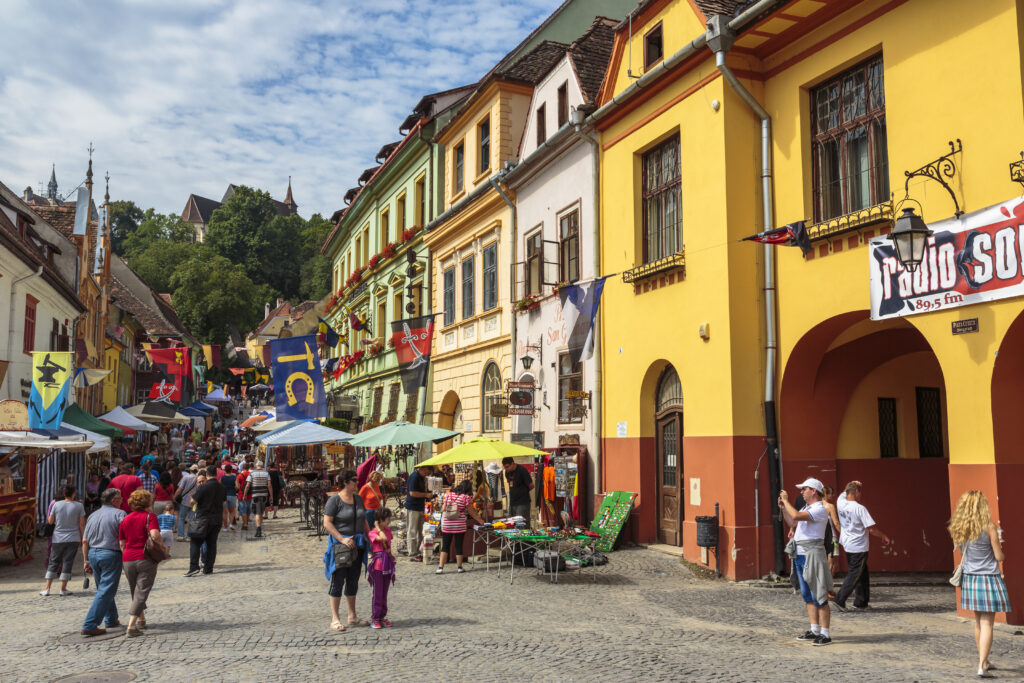
One of the things that sets Citadel Square apart is its well-preserved architecture. The colorful buildings lining the square each had a unique charm and character.
We also noticed a fascinating building called the Stag House. The Stag House, also known as Casa cu Cerb. Its distinctive architectural style and intricate details made it stand out amidst the surrounding structures. Its name derives from the intricate deer motifs that adorn its facade, capturing the attention of anyone passing by.
The square is also home to several notable landmarks, like the Clock Tower and the Church on the Hill. These iconic spots add to the square’s allure and make it a must-visit destination for travelers from all over the world.
Towers
We also visited some of the city’s famous towers, like the Tailors’ Tower and the Bootmakers’ Tower.
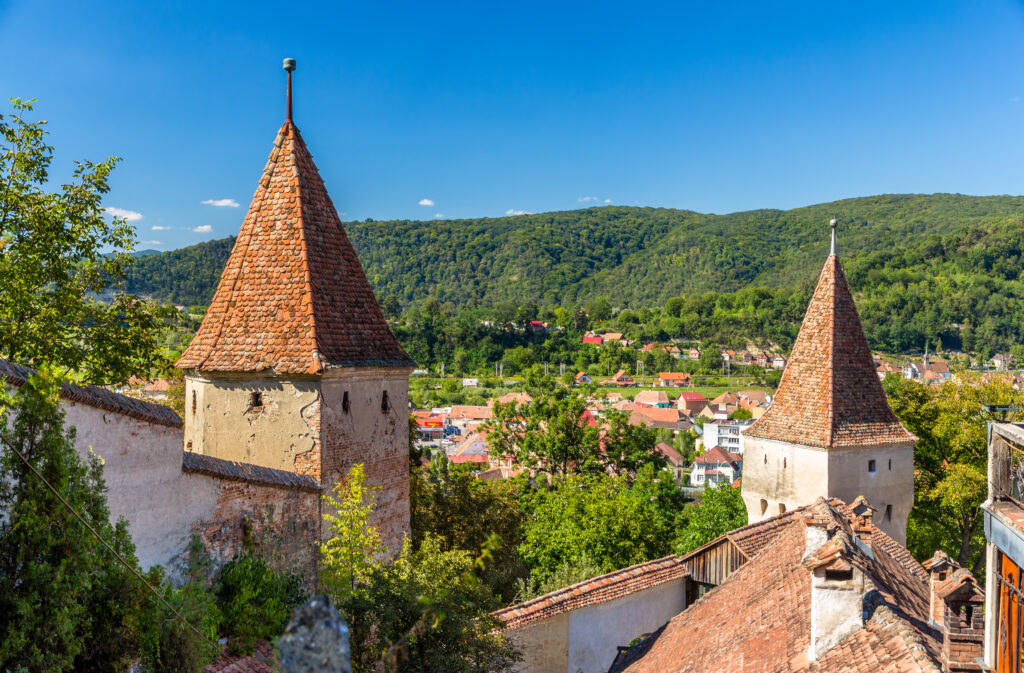
These towers were once part of the city’s fortifications and are now popular tourist attractions. We list some of Sighisoara’s most famous towers below!
Covered Stairway / Pupils’ Staircase
Next, we went up the Covered Stairway, also known as the Pupils’ Staircase. The Covered Stairway is a pretty big deal in Sighișoara, and there’s a good reason for that. This unique architectural wonder has earned its fame for being one of the few covered staircases in Europe.
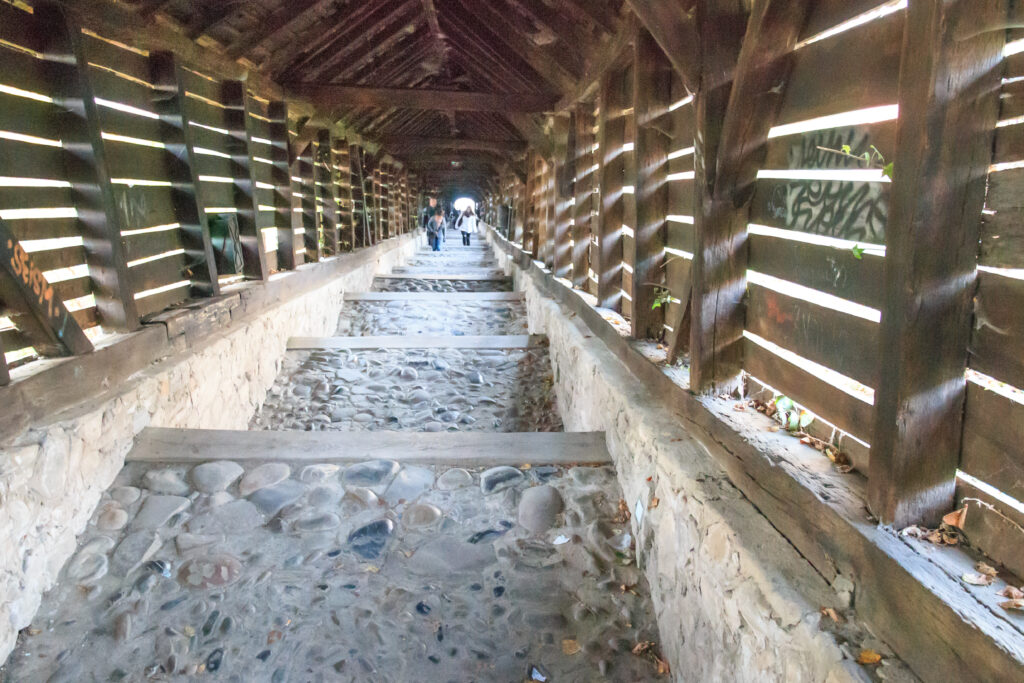
Now, let me tell you about the legends surrounding this staircase. As legend has it: for every step you take up the stair case, you must kiss your lover and say their name out loud. Yep, you heard that right! According to the legend, this ritual ensures everlasting love and a deep connection with your significant other.
We playfully followed the tradition, exchanging kisses and saying each other’s names with every step, but we didn’t last very long! It was a lighthearted and fun experience that made our visit to the Covered Stairway memorable.
Beyond the legends and traditions, the Covered Stairway holds a fascinating history. It’s said to have been built in the 17th century to provide shelter and protection from the elements as students made their way to and from a school built on top of the hill. The fact that it still stands today, preserving its original charm, is truly remarkable.
Originally, the Covered Stairway boasted an impressive total of 300 steps, making it quite a challenging climb for those who ventured up its path. Over time, however, the Covered Stairway underwent changes and underwent a significant reduction in its number of steps. The stairway we see today consists of 176 steps, a considerable decrease from its original count. The reasons behind this modification are not entirely clear, but it’s likely that renovations, repairs, and adjustments to accommodate modern needs contributed to the alteration.
As we reached the top of the Covered Stairway, we were rewarded with a breathtaking view of the town below. The red rooftops, cobblestone streets, and colorful facades stretched out before us, painting a picturesque scene that seemed straight out of a storybook.
Evangelical Cemetery
The Evangelical Cemetery is a fascinating place that dates back to the 1700s, and let me tell you, it’s steeped in history. As we entered the cemetery grounds, we noticed its peaceful atmosphere.
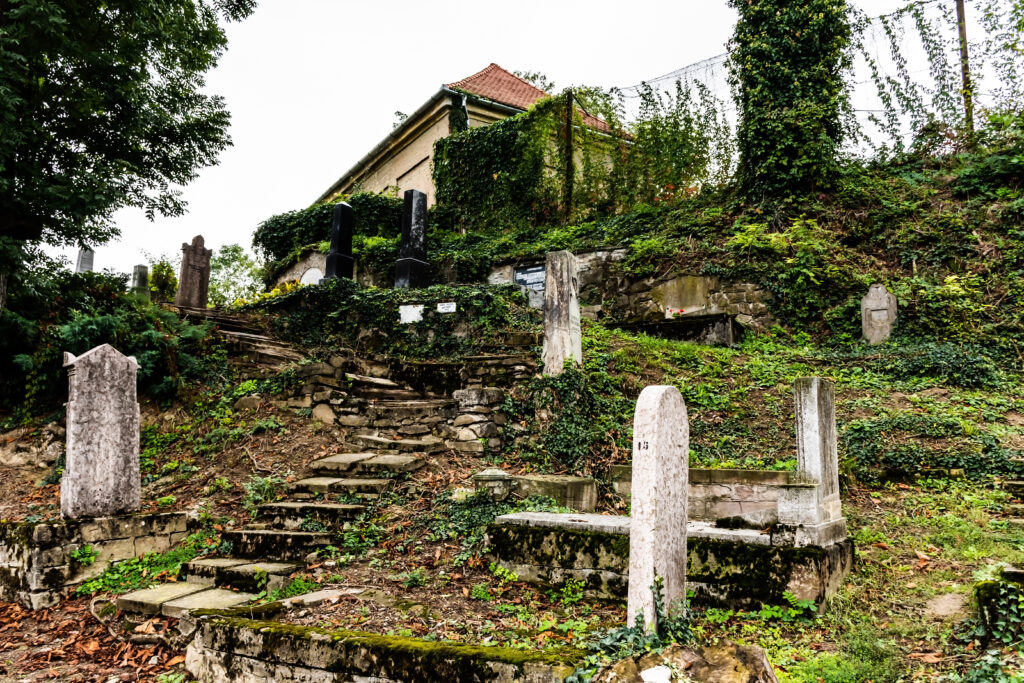
We strolled around the cemetery for a few minutes, taking in the sights and paying our respects to the departed souls resting here. The gravestones and monuments bore the marks of time, their weathered surfaces telling stories of lives lived long ago.
After exploring the cemetery, we made our way to the adjacent Church on the Hill.
Church on the Hill
Our final stop in Sighisoara was the Church on the Hill. As we were strolling around, some caretakers noticed our curiosity and kindly invited us inside the Church on the Hill. Without hesitation, we gladly accepted their invitation.
The church, dating all the way back to 1345, stood proudly before us. It had witnessed centuries of history and transformation. We noticed an altar dedicated to St. Nicholas, the original saint to whom the church was devoted. It was a nod to its Roman Catholic origins, although its affiliation has changed over time.

One of the interesting features we discovered was an altar dedicated to Jesus’ grandmother, believed to be named Anne. It was a unique homage to this lesser-known figure, and it added an interesting twist to the church’s religious narrative.
One of the most captivating features of the Church on the Hill, in my opinion were the hidden frescoes. These stunning artworks were actually concealed and whitewashed for many years. It was during the church’s restoration that the true beauty of these frescoes was unveiled as they carefully removed layers of plaster.
We also found ancient wooden chests that had weathered over 500 years. Each chest belonged to a family in the town, serving as a storage of supplies they would rely on during times of attack or when they sought refuge within the church. These chests were a tangible reminder of the town’s tumultuous past and the resilience of its people.
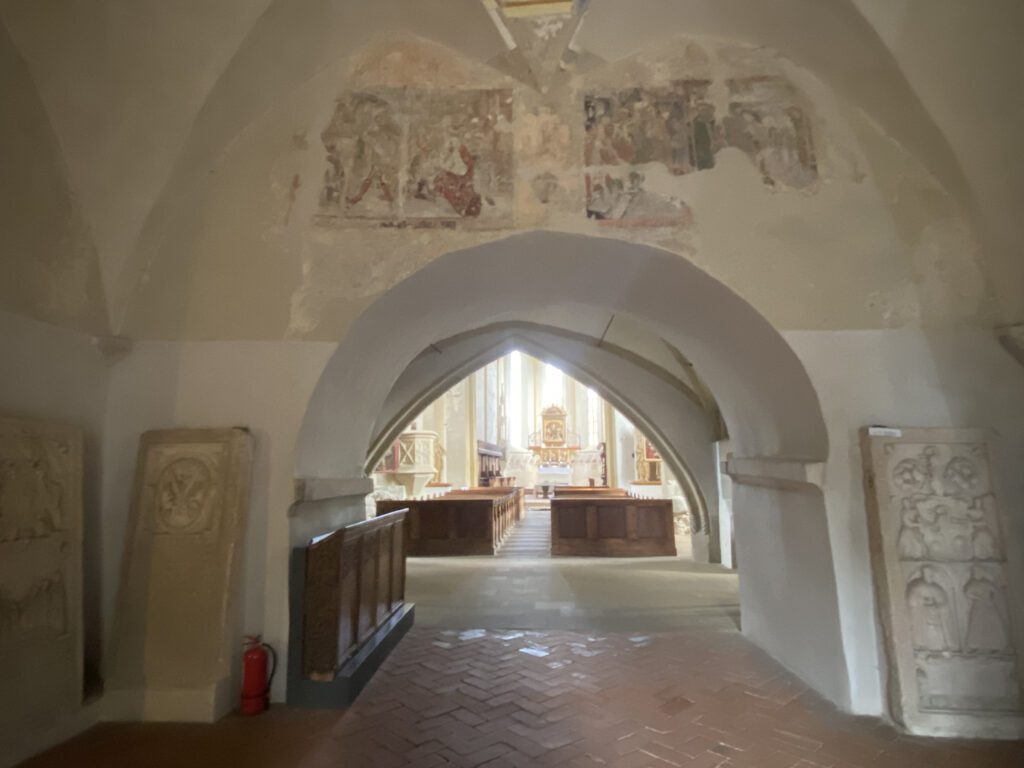 The interior (entrance area) of the Church on the Hill
The interior (entrance area) of the Church on the Hill
Venturing further, we explored the small dark crypt beneath the church, a rare find in Eastern Europe. It contained a couple of displays showcasing fragments of wooden coffins and decayed remains, which were visible through glass.
Going back up to the main area, our attention was drawn to intricately carved headstones leaning against the walls. These delicate works of art had once adorned the church floor but had been carefully moved to protect them from being walked upon. They stood as silent testimonials to the craftsmanship and reverence of the past.
Our visit to the Church on the Hill was a journey through time and faith, filled with discoveries at every turn. It reminded us of the layers of history woven into the fabric of Sighișoara, waiting to be uncovered by curious souls like us.
Towers of Sighisoara
Sighișoara is known for its well-preserved medieval citadel and a collection of famous towers. Being one of the last few fortified and walled cities in Europe, it is designated as a UNESCO World Heritage Site. Here are some of the notable towers in Sighișoara:
- Tailors’ Tower (Turnul Croitorilor): Situated near the Clock Tower, the Tailors’ Tower is another significant tower in the citadel. Originally built in the 15th century, it served as a defensive tower and later became a prison. Today, it houses a small museum dedicated to medieval armaments and offers panoramic views of Sighișoara.
- Butchers’ Tower (Turnul Măcelarilor): Located on the northeastern side of the citadel, the Butchers’ Tower dates back to the 14th century. It served as a defensive tower and storage space for meat during the Middle Ages. The tower offers visitors the chance to climb to its top, providing beautiful views of the city.
- Blacksmiths’ Tower (Turnul Fierarilor): Situated near the Church on the Hill, the Blacksmiths’ Tower is another prominent tower in Sighișoara. Originally built as a defensive tower, it was later used as a prison. Today, it houses a small exhibition showcasing medieval instruments of torture.
- Ropemakers’ Tower (Turnul Frânghierilor): Situated in the southwestern part of the citadel, the Ropemakers’ Tower is named after the craftsmen who used to produce ropes there. It is one of the smaller towers in Sighișoara but still adds to the city’s medieval charm.
These towers, along with the fortified walls and the citadel’s overall architecture, contribute to the unique character and atmosphere of Sighișoara. They provide visitors with an opportunity to explore the city’s rich history, enjoy beautiful panoramic views, and immerse themselves in the medieval atmosphere that still lingers within the walls of this enchanting Transylvanian city.
Conclusion
If you’re considering a visit to Sighișoara, let me give you a few reasons why you should go. First and foremost, the town’s rich history and well-preserved architecture create a captivating atmosphere that transports you back in time. Whether you’re exploring the Citadel Square, wandering through the narrow alleys, or marveling at the fortified walls, there’s an undeniable sense of stepping into a bygone era.
Secondly, Sighișoara’s unique blend of cultures and influences, from its German heritage to its Transylvanian roots, creates a melting pot of traditions, gastronomy, and customs that will intrigue and delight you.
And let’s not forget the warm hospitality of the locals, who are more than happy to share their stories and recommendations, making your visit even more memorable.
So, pack your bags, venture into the heart of Transylvania, and immerse yourself in the enchanting world of Sighișoara. You won’t be disappointed!
WATCH THE FULL VIDEO HERE
Like this post? Pin it on Pinterest!

